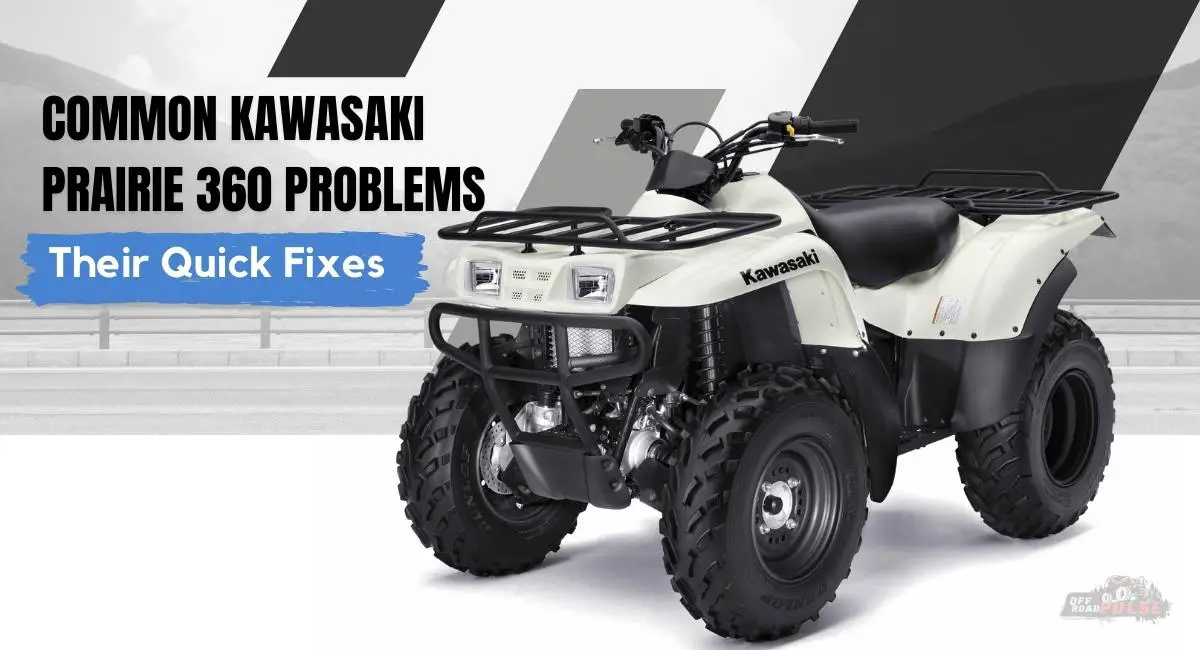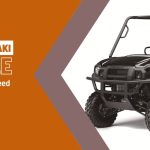Kawasaki Prairie 360 is popular for its unique durability and aesthetics. The 4-wheeled ATV offers a compact design, good performance, and other amazing features at only about half the price of its parent model – Kawasaki Prairie 650.
But to think this ATV is all good with no problems at all is to live in a fantasy land. Most riders that have done a lot of off-roading with this machine can tell you there are quite some problems with this vehicle.
But what are some of these problems? And how do you diagnose them? Any quick-fix tricks to handle them when they occur?
This article will answer all these and more.

Common Kawasaki Prairie 360 Problems
Some of the issues with Kawasaki Prairie 360 are common other ATVs, while several others are peculiar to the mode. But here’s the good part – you’ll be able to troubleshoot them all like a pro if you follow my recommendations carefully.
Below, we consider seven common Kawasaki Prairie 360 problems and how to fix them:
1. Startup Issues Due to Faulty Spark Plugs or Stale Fuel
If you own a Kawasaki Prairie 360 machine, startup hitch is one problem you must be prepared to deal with. In fact, over the past few years, users have reported more complaints about startup problems from the vehicle than any other.
But why is this so?
Well, one major reason is that the utility vehicle is cold-natured. Because of this startup problems with the model are most prevalent during the cold times of the year.
Another common cause of startup issues in Kawasaki Prairie 360 is the presence of dirt around spark plugs.
Overtime, they (spark plugs) could become corroded or dirty. With the rust and/or debris around spark plugs, they can’t ignite the spark of electricity your ATV machine requires to start. No matter how hard you try, your machine will not start anytime either happens.
What more?
Keeping stale fuel in the tank is another angry mob that will always come for your ATV machines. Just like foods don’t stay fresh forever, fuel doesn’t remain “fresh” in the tank after a long time. You may not know this, but the longer fuel stays in your tank, the lesser effective they are to combust.
So, how do you fix startup issues?
Solution: Before you jump into the do-it-yourself spirit, the first step is to diagnose the Kawasaki Prairie 360 starter problems you’re dealing with. Once you know what is wrong, you can apply the appropriate remedy from the options below:
- Corroded or dirty spark plugs: Remove the rust or dirt with a wire brush. If the damage is intense, replace the plugs with new ones.
- Old fuel: Drain the stale fuel. Then, use a motor treatment oil to clear out the rest of the stale fuel in the tank. Now pour in fresh fuel, and start your vehicle.
2. Carburetor Issues Like Clogging, Especially During Cold Weather
A malfunctioning carburetor is perhaps the most frustrating fault ATVs develop. Although any machine model can develop carburetor issues, the damage frequency in Kawasaki Prairie 360 is high. The model tends to gum up more, especially during cold weather. Besides this, you may also find your carburetor developing frequent issues if you ride more on untarred or muddy paths.
In most instances, the pilot jets in your carburetor is the victim when any of these happens. Among other signs, the commonest symptom you will notice when your ATV’s carburetor is bad is startup issues.
But since problems other than a faulty carburetor can cause startup issues, the big question now is how to distinguish Kawasaki Prairie 360 carburetor problems from others. Here’s how:
First, take note of the typical outside temperature during the instances when your machine malfunctions this way. If it is only when the temperature is low, the problem is likely from the carburetor.
Another thing you should check is how long you need to keep your vehicle on choke to remain active while it’s on the move. If it takes up to five minutes and the engine makes a popping sound, the carburetor might be clogged.
In some instances, the engine may not even start at all. You may also notice fuel overflow and black sooty smoke from the exhaust.
Whenever you notice any of these, you can be sure something is wrong with your carburetor.
Solution: Already confirmed your carburetor is bad? Here’s how to resolve the issue like a pro:
- Mix water and any available all-purpose cleaner in a ratio of 3:1.
- Carefully remove the carburetor.
- Take out the components, particularly the pilot jets and the float.
- Soak the removed carburetor parts in the prepared solution for 10 or 15 minutes.
- Pass a wire through the pilot jets to remove clogs within them.
- Couple the components again and start your machine.
Apart from cleaning, below are a few other tricks that may help prevent carburetor issues and troubleshoot faults:
- Inspect your carburetor gasket for wear and loose connections. If you sight any, replace the damaged parts.
- Examine the carburetor’s needle, seat, and fuel lines for any signs of wear or tear. Next, replace any damaged parts promptly to ensure proper fuel delivery.
3. Battery Issues (Dead Battery or Dirty Battery Terminals)
Battery issues are another problem you may encounter using Kawasaki Prairie 360. With a dead battery or dirty battery terminal, nothing you do can make your machine work.
A careful inspection will tell if your machine’s battery terminals are dirty. However, to troubleshoot a dead battery, you’ll need to get a multimeter, connect it to the battery terminals, and check the voltage reading. If the multimeter calibrator doesn’t move, the battery is dead.
Solution: For a dead battery, you have two options. If you’re good with your hands, you can jumpstart the vehicle. Otherwise, take the dead battery to a mechanic for recharging.
As for debris-coated battery terminals, simply apply a battery cleaner on the terminals and scrub with a wire brush till all the debris is gone.
You can also prepare a makeshift cleaner using baking soda and warm water. Mix both in a small plate, apply on the battery heads, and scrub with a wire brush. Finally, start your ATV and see if the battery will work as expected.
4. Poor Stability When Drifting, Cornering, or on Top Speed
If you ride on paths with plenty of corners or loves drifting, this is one problem you cannot avoid. Every time you make a turn in a sharp corner, you find your vehicle tipping. You may even find the instability quite scary when on a Kawasaki Prairie 360 top speed (anything between 45 and 55 mph).
Don’t panic. It’s not you – it is the bulky frame of your machine. This can be scary, especially when an overturning occurs, but there’s always a way out.
Solution: To improve the stability of your machine while cornering or drifting, here are two simple things you can do:
- Adjust the spring preload settings on the wheel. The settings of your vehicle’s preload spring determine the comfort level your machine gives. Reducing the preload spring to the softest setting can help improve the stability.
- Replace your machine’s stock tires with any other more rigid alternatives.
5. Shifting Problems (Grinding Noise While Changing Gears)
You may hear some grinding noise when you shift gears. Most owners encountering this stated the problem is usually most obvious when they change from neutral to high and neutral to reverse.
Unlike the other issues discussed above, this isn’t a technical fault and only requires a simple solution. Here’s what you should do if you notice any Kawasaki Prairie 360 shifting problems while off-roading.
Solution: In most cases, you are likely to You hear the sound because your machine is not idle enough. Simply idle the machine by pressing the brake on the left handle before changing gears. This would fix the problem, and all the noise will be gone.
6. Worn-Out/Clogged Intake Valves Resulting in Compression Loss
Many owners of this ATV model also complain about mechanical issues with the intake valve. The intake valve regulates fluid inflow into the cylinder of your utility vehicle’s engine. Like the carburetor or any other parts of an ATV, intake valves can wear over time and become clogged with foreign substances.
When this happens, there is compression loss through the valves. The tell-tale signs you can expect when there is compression loss from intake valves include:
- Startup issues
- Rough idling, and
- Stalling
Solution: For this, you should have an expert ATV mechanic inspect the problem and recommend the best solution to the circumstance at hand.
7. Radiator Issues (Clogging Due to Accumulated Dust/Debris)
As I stated earlier, riding on untarred and muddy paths doesn’t do so much good to ATVs. The reason is that rough and dusty roads can clog many parts of your vehicle. Apart from the carburetor and battery terminals I mentioned earlier, the radiator is another functional part of your machine that can quickly get clogged.
Clogging in the radiator will inhibit the coolant flow and, in no time, lead to overheating. Excessive overheating will in turn cause a blown head gasket and damage your machine’s engine.
Solution: Remove the components (radiator and cooler), wash them, and reinstall them. Here’s a five-step procedure to clean the components after removing them:
- Mix water (three parts) and all-purpose cleaner (one part) in a sizable container.
- Pressure-wash the cooler
- Soak the radiator in the prepared solution for a few hours
- Remove the radiator from the solution and pressure-spray
- Reinstall the cooler and radiator.
Conclusion
Kawasaki Prairie 360 has fantastic features, just like the rest of its siblings. However, it has its downsides, and we discussed seven of them above. To recap, some of the common Kawasaki Prairie 360 problems you can expect are radiator issues, shifting problems, worn-out intake valves, poor drifting stability, carburetor issues, and battery problems.
But the good part is, these are all simple issues you can fix like a pro, even if you’re not a mechanic. Simply follow the recommended solutions carefully. But if your best is not good enough, I advise you to seek the help of a professional ATV mechanic.




